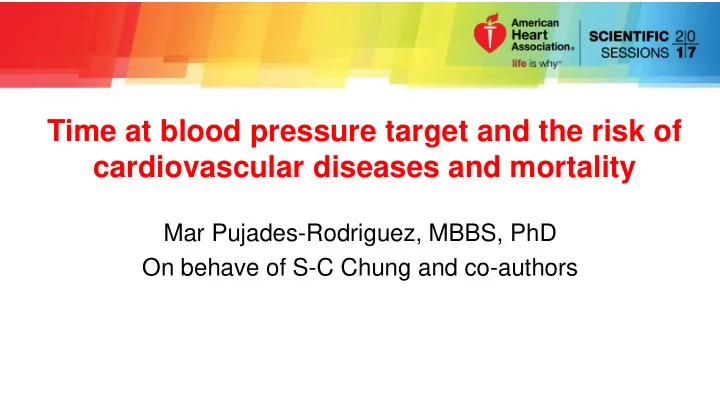

Time at blood pressure target and the risk of cardiovascular diseases and mortality Mar Pujades-Rodriguez, MBBS, PhD On behave of S-C Chung and co-authors
Introduction • Effective long term lifestyle and pharmacological interventions to lower blood pressure (BP) in reducing cardiovascular morbidity and mortality • Suboptimal BP control is common (19-50%) • The time a patient spends with BP at target level might be an important measure of hypertension care effectiveness • However, this has not been evaluated in the general population
Study aims • To describe the average TIme per year spent by newly identified hypertensive patients at BP care TaRgEt (TITRE) • To investigate factors associated with TITRE • To assess the relationship between TITRE and cardiovascular outcomes
Methods (I) • Design: Population record-linkage cohort of patients newly identified with high BP in CALIBER, England • Study period: Jan 1997 – March 2010 • Primary endpoints: – CVD composite: incident cardiovascular death, acute myocardial infarction and stroke – incident heart failure – composite of any incident CVD and death • Secondary endpoints: incident stable angina, peripheral arterial disease and all-cause mortality
Methods (II) Inclusion criteria: • ≥ 18 years old • ≥ 1 year CPRD registered • No prior CVD or hypertension • ≥6 months follow -up TITRE: Annual % time, averaged over years of High High High BP on BP on follow-up BP BP BP target target 1 year Study end Study entry High BP : ≥ 140/90mmHg On target BP : <140 & 90mmHg (≥150/90 if ≥60 years without diabetes and CKD)
Methods (III) • Baseline covariates: – Demographic: age, sex, year of study entry, ethnicity, index of multiple deprivation – Cardiovascular: smoking, BMI, diabetes mellitus, total cholesterol, renal dysfunction (eGFR<60 mL/min/1.73m 2 ) – Hypertension severity : stage 2 (SBP ≥160 or DBP ≥100 mmHg) – Treatment: statin, aspirin Covariates during follow-up: – Lifestyle interventions: nutritional and smoking cessation – Treatment: initial BP lowering drug class
Study flow chart definition CALIBER patients Cohort 2.68M Study population 169,082 Median follow-up: 5 yr (IQR 3-7) BP reads during study period Follow- up BPs 1.93M Time at BP target (TITRE) Median BP reading: 7 (IQR 3-16) 1.64M BP readings from 150,130 patients points Incident fatal & non-fatal CVDs: 5684 (3.4%) End- CVD composite: 409 Heart failure: 318 Fatal CVD composite: 332
Patient characteristics Baseline characteristics N=169,082 Age, mean (years) 52 Women 56% Stage 2 hypertension 38% Diabetes 5% Characteristics during follow-up BP lowering medication 46% Thiazide diuretics 16% Angiotensin-converting enzyme inhibitors 15% Dietary advice 29% Smoking cessation 2% Snapshot ‘control’ during the first year 47%
Time at target (TITRE) distribution (N=150,130) Median TITRE: 2.8 (IQR 0.3 – 5.6) mths per year Percentage Time at target (TITRE, average months per year)
Distribution of study patients by TITRE category 18,952 (11%) 25,866 (15%) 7557 (5%) 0 mths <3 mths 3-6 mths 6-9 mths 25,237 (15%) 9-12 mths BP missing 51,819 (31%) 39,651 (23%)
Associations between patient characteristics & greater TITRE categories (6-8 mths vs. 3-5.9 mths) Note: Generalised nominal models
Association between TITRE and endpoints CVD composite Heart failure Note: n(%) indicates the no. of events in each category of TITRE; generalised mixed effects models weighted for duration of follow-up
Association between TITRE and endpoints Any CVD and death Note: n(%) indicates the no. of events in each category of TITRE; generalised mixed effects models weighted for duration of follow-up
Results of sensitivity analyses • Consistent findings: – amongst patients who achieved or not ‘snapshot’ control – across groups defined by the average no. of BP readings – models additionally adjusted for the no. of BP readings or SBP visit-to-visit variability • Close to null associations observed when alternative BP measures replaced TITRE: – averaged BP value – SBP visit-to-visit variability
Summary and conclusions • Few newly identified hypertensive patients sustained a complete, year-round on-target BP over time • A higher time at target was associated with a lower risk of incident CVDs, independent of widely used BP control indicators • Stronger CVD dose-response associations with TITRE than with other BP measures • Need to compare interventions to increase a person’s time spent at BP target with those aimed at achieving lower BP target
Recommend
More recommend